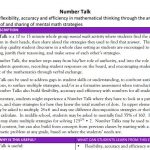Number Talks Cheat Sheet
What does Number Talks look like?
- Students are near each other so they can communicate with each other (central meeting place)
- Students are mentally solving problems
- Students are given thinking time
- Thumbs up show when they are ready
- Teacher is recording students' thinking
Communication
- Having to talk out loud about a problem helps students clarify their own thinking
- Allow students to listen to other's strategies and value other's thinking
- Gives the teacher the opportunity to hear student's thinking
Mental Math
- When you are solving a problem mentally you must rely on what you know and understand about the numbers instead of memorized procedures
- You must be efficient when computing mentally because you can hold a lot of quantities in your head
Thumbs Up
- This is just a signal to let you know that you have given your students enough time to think about the problem
- If will give you a picture of who is able to compute mentally and who is struggling
- It isn't as distracting as a waving hand
Teacher as Recorder
- Allows you to record students' thinking in the correct notation
- Provides a visual to look at and refer back to
- Allows you to keep a record of the problems posed and which students offered specific strategies
Purposeful Problems
- Start with small numbers so the students can learn to focus on the strategies instead of getting lost in the numbers
- Use a number string (a string of problems that are related to and scaffold each other)
Starting Number Talks in your Classroom
- Start with specific problems in mind
- Be prepared to offer a strategy from a previous student
- It is ok to put a student's strategy on the backburner
- Limit your number talks to about 15 minutes
- Ask a question, don't tell!
The teacher asks questions:
- Who would like to share their thinking?
- Who did it another way?
- How many people solved it the same way as Billy?
- Does anyone have any questions for Billy?
- Billy, can you tell us where you got that 5?
- How did you figure that out?
- What was the first thing your eyes saw, or your brain did?
- What are Number Talks and Why are they
Strategies by Grade Level
| Grade | Addition | Subtraction |
| K |
Counting all/counting on Making tens
|
Counting back
Adding up |
| 1 |
Counting all/counting on Doubles/near doubles Making tens Breaking up number into their place value Adding up in chunks
|
Adding up
Removal in parts |
| 2 |
Counting all/counting on Doubles/near doubles Making tens Breaking up number into their place value Adding up in chunks
|
Adding up
Removal in parts |
| 3 | Breaking numbers into their place value
Adding up in chunks Compensation Problem using a landmark number |
Adding up Negative numbers Constant difference Adjusting 1 number to make an easier problem Number line Part - whole box model
|
|
Repeated addition Skip counting Doubling and halving making an array as a model Partial products Using landmark numbers |
||
Students need to understand that:
- Numbers are composed of smaller numbers.
- Numbers can be taken apart and combined with other numbers to make new numbers.
- What we know about one number can help us figure out other numbers.
- What we know about parts of smaller numbers can help us with parts of larger numbers.
- Numbers are organized into groups of tens and ones (and hundreds, tens and ones and so forth.)
- What we know about numbers to 10 helps us with numbers to 100 and beyond
